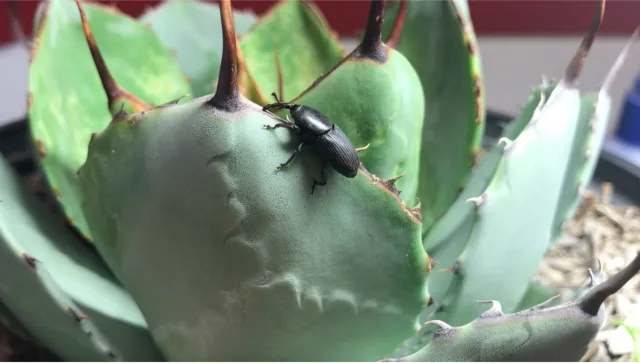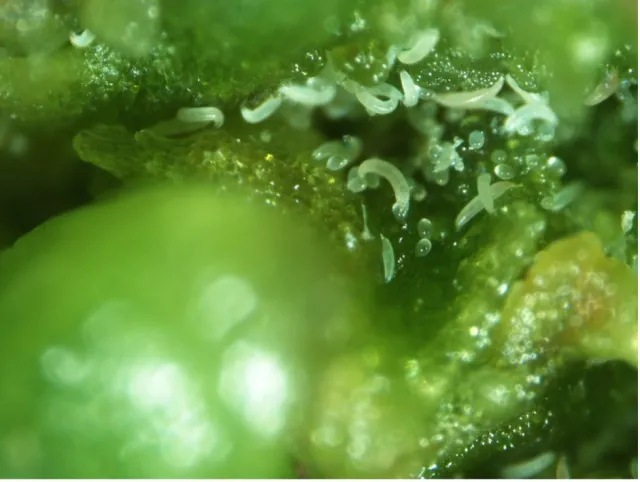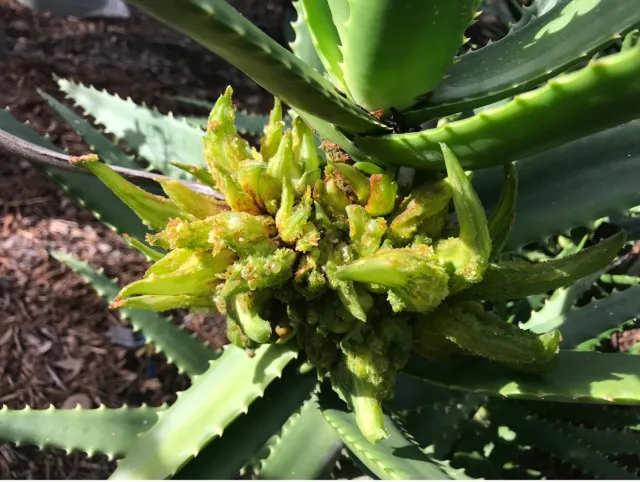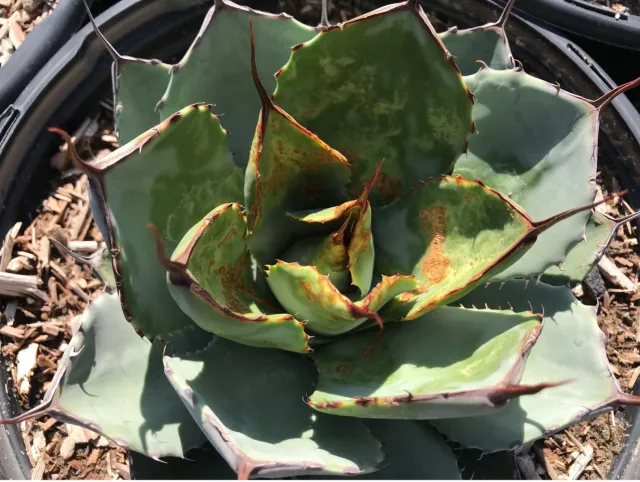Succulents like aloes and agaves are common landscape plants throughout much of California and are prized both for their beauty and their drought tolerant features. Unfortunately there are several arthropod pests that can damage or even kill these hardy plants. Below are three pests you should be aware of if you have either aloes or agaves in your yard or garden.
Agave Snout Weevil
Agave snout weevil (Scyphophorus acupunctatus) is a serious pest of agave that can rapidly kill plants. Adults bore holes into the base of agave plants and lay eggs that hatch into larvae. The larvae feed on the plant, tunneling into the base and destroying roots and other tissue. Larval feeding and secondary infections that develop within larval feeding wounds usually kill affected plants. Many kinds of agave are susceptible, including full grown Agave americana.

Unfortunately, it is difficult to detect agave snout weevil infestations before symptoms develop. Often the first signs of a weevil infestation will be entire plants separating from their roots or collapsing. Be vigilant for the small entrance holes that adults leave at the base of plants, or for dying leaves or discoloration low on the plant. Both of these signs indicate that a weevil infestation is in progress. Remove infested plants and discard the soil around the roots to remove any remaining weevils, their larvae, and pupae. Finally, agave snout weevils prefer agave with large to medium-sized leaves, so consider plantings narrow-leafed varieties in your area if weevils are consistent issues.

Aloe Mite
Aloe mite (Aceria aloinis), also known as aloe gall mite, is a microscopic pest that lives on the surfaces of aloe leaves and flower stalks. While these mites are too small to see without magnification, the damage caused by their feeding is readily apparent. Aloe mite feeding causes tumorlike growths, bubbly distortions, and clusters of tightly packed new leaves growing together on numerous species and varieties of aloe and the aloelike succulents Gasteria and Haworthia. Aloe mites can stunt plant growth. The distortions they cause are permanent, although they rarely kill the plant.

When it comes to controlling aloe mites, first consider how much damage you are willing to tolerate. If you are fine with some distortions on your aloes, then it may not be worth your time or effort to manage. If you are concerned about damage or have particularly susceptible plants, prevention and sanitation measures will produce the greatest impacts. Aloe mites are so small they can travel on air currents, so take care when moving infested material since mites may drift off. Monitor your aloes regularly so you catch any symptoms early and can act quickly to prevent aloe mite populations from building up. This is especially important since it can take weeks or months after an aloe mite infestation begins before symptoms appear. Remove infested aloes or cut out pieces of distorted tissue and dispose of them in an area downwind of other aloes.
Numerous miticides can control aloe mites, including commercially available insecticidal soap. Other products that can only be applied by licensed applicators have also been shown to be effective against aloe mites. No matter what insecticide is being used, it is important to get very thorough coverage when applying any miticides to reach all aloe mites hidden on the plant. Apply miticides to infested aloes and to aloes near infested aloes where mites may have spread. While some natural enemies like predator mites can feed on aloe mites, it is unclear whether they will reduce aloe mite populations.

Agave Mite
Agave mites (Oziella sp.) are also called grease mites and are similar overall to aloe mites. Agave mites feed on the surface of leaves but live hidden at the very base of agave leaves or deep inside the core of the plant. Agave mite feeding causes greasy streaks and lesions on leaves. In severe infestations, they can stunt plant growth, cause the core to collapse, and sometimes even kill the plant. The full host range of agave mites is not known, but they seem to prefer agave with a powdery blue appearance and medium-sized leaves. Common examples of susceptible agave include blue glow agave and Parry’s agave.
As with aloe mites, consider how much damage you are willing to tolerate. While damage symptoms are permanent, mite infestations sometimes disappear on their own for unknown reasons. Agave mites usually don’t kill agave, but severe infestations can kill particularly susceptible plants. Managing agave mites is difficult; since agave mites are protected within the core of the agave, most miticides don’t provide control. Prevention and sanitation will be your best management tools. Strongly consider removing infested agave plants and be careful when moving them since like aloe mites, agave mites may be spread by the wind. Be vigilant for agave mite damage and try to detect infestations as early as possible since agave mites will be present for 3-5 months on a plant before symptoms appear. While most miticides will not cure existing infestations, experiments in commercial nurseries show some can be applied preventatively to protect uninfected plants. This may also be true of other contact miticides, and home gardeners can consider applying products insecticidal soap to agave close to infested agave as a preventative treatment. As with aloe mites, some natural enemies like predator mites may feed on agave mites, although it is unclear whether this predation will significantly reduce agave mite populations.

[Originally featured in the Summer 2025 edition of the Home and Garden Pest Newsletter.]

